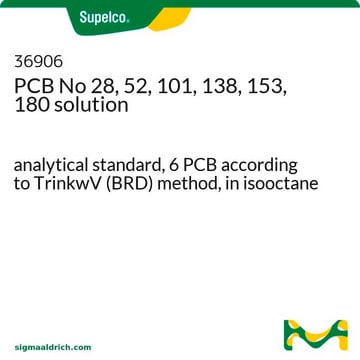35586
PCB No 1
analytical standard
Synonym(s):
2-Chlorobiphenyl, 2-PCB
Sign Into View Organizational & Contract Pricing
All Photos(1)
About This Item
Empirical Formula (Hill Notation):
C12H9Cl
CAS Number:
Molecular Weight:
188.65
Beilstein:
1907934
Ballschmiter Number:
1
EC Number:
MDL number:
UNSPSC Code:
41116107
PubChem Substance ID:
NACRES:
NA.24
Recommended Products
grade
analytical standard
Quality Level
shelf life
limited shelf life, expiry date on the label
technique(s)
HPLC: suitable
gas chromatography (GC): suitable
application(s)
environmental
format
neat
SMILES string
Clc1ccccc1-c2ccccc2
InChI
1S/C12H9Cl/c13-12-9-5-4-8-11(12)10-6-2-1-3-7-10/h1-9H
InChI key
LAXBNTIAOJWAOP-UHFFFAOYSA-N
General description
3-Chlorobiphenyl is a chlorinated biphenyl compound, which can be prepared, via phase transfer Gomberg-Bachmann-Hey reaction. It involves the condensation of 3-chlorobenzenediazonium tetrafluoroborate with 18-crown-6 in the presence of potassium acetate.
Polychlorinated biphenyls (PCBs) are a class of highly toxic pollutants found in various environmental matrices and food products. They find a variety of applications as flame retardants, plasticizers, dielectric and heat transfer fluids, etc.
Application
PCB No 1 may be used as an analytical reference standard for the quantification of the analyte in natural matrices using an on-line system for subcritical water extraction combined with high-performance liquid chromatography (HPLC).
Refer to the product′s Certificate of Analysis for more information on a suitable instrument technique. Contact Technical Service for further support.
Signal Word
Warning
Hazard Statements
Precautionary Statements
Hazard Classifications
Aquatic Acute 1 - Aquatic Chronic 1 - STOT RE 2
Storage Class Code
11 - Combustible Solids
WGK
WGK 3
Flash Point(F)
Not applicable
Flash Point(C)
Not applicable
Personal Protective Equipment
dust mask type N95 (US), Eyeshields, Gloves
Choose from one of the most recent versions:
Already Own This Product?
Find documentation for the products that you have recently purchased in the Document Library.
Cepanec I
Synthesis of Biaryls, 2010 null
On-line coupling of subcritical water extraction with high-performance liquid chromatography via solid-phase trapping
Li B, et al.
Journal of Chromatography A, 873(2), 175-184 (2000)
Christopher P O'Brien et al.
Environmental science & technology, 39(17), 6839-6844 (2005-09-30)
Incineration is commonly used to destroy polychlorinated biphenyl (PCB) wastes, but this method of treatment is not ideal for all mixed liquid wastes, especially those containing radioactive materials. Therefore, other remediation technologies are needed to efficiently treat these waste forms.
Hyeok Choi et al.
Environmental science & technology, 43(11), 4137-4142 (2009-07-03)
Reactive activated carbon (RAC) impregnated with palladized iron has been developed to effectively treat polychlorinated biphenyls (PCBs) in the environment by coupling adsorption and dechlorination of PCBs. In this study, we addressed the dechlorination reactivity and capacity of RAC toward
Degradation of anaerobic reductive dechlorination products of Aroclor 1242 by four aerobic bacteria.
O V Maltseva et al.
Biodegradation, 10(5), 363-371 (2000-06-28)
We studied the aerobic degradation of eight PCB congeners which comprise from 70 to 85% of the anaerobic dechlorination products from Aroclor 1242, including 2-, 4-, 2,4-, 2,6-, 2,2'-, 2,4'-, 2,2', 4-, and 2,4,4'-chlorobiphenyl (CB), and the biodegradation of their
Our team of scientists has experience in all areas of research including Life Science, Material Science, Chemical Synthesis, Chromatography, Analytical and many others.
Contact Technical Service










